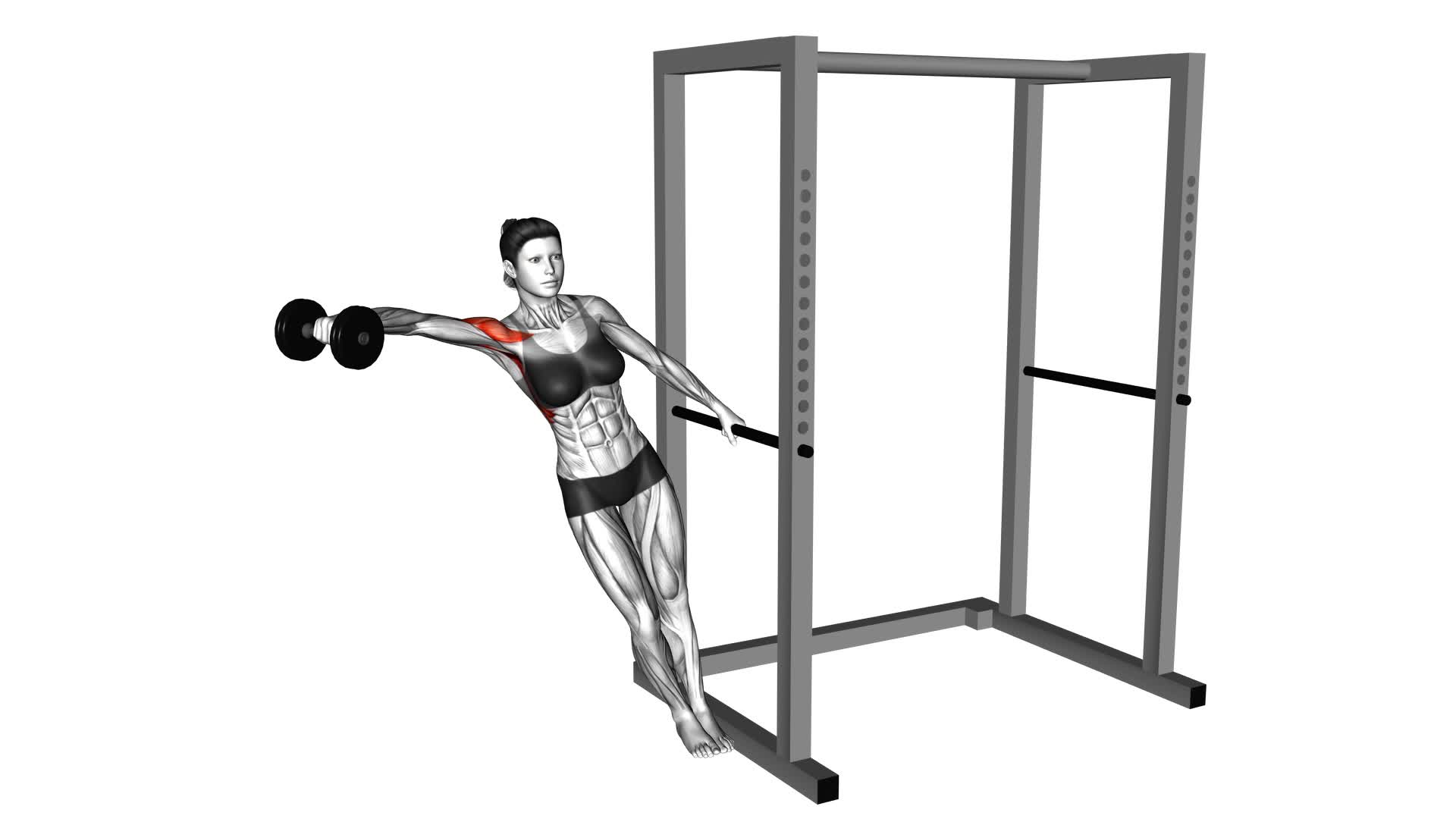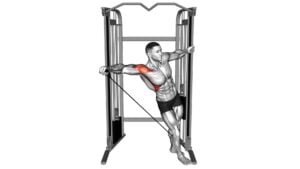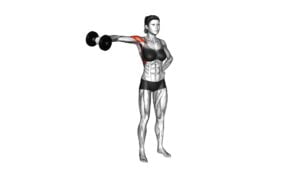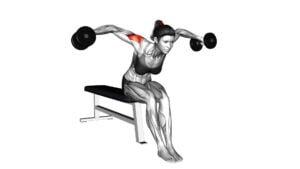Dumbbell Single Arm Leaning Lateral Raise (Female) – Video Exercise Guide & Tips

Are you looking to tone and strengthen your shoulders? The dumbbell single arm leaning lateral raise is a fantastic exercise for targeting those muscles. In this video exercise guide, we'll show you the proper technique to maximize the benefits of this exercise.
Watch This Exercise Video
We'll also share common mistakes to avoid and tips to increase the intensity. Get ready to take your shoulder workout to the next level with this effective variation.
Let's get started!
Key Takeaways
- Targets shoulder muscles for activation and strength
- Tones and strengthens deltoids
- Improves shoulder stability and strength
- Engages core muscles for improved stability and posture
Benefits of the Dumbbell Single Arm Leaning Lateral Raise
You can experience several benefits from performing the Dumbbell Single Arm Leaning Lateral Raise. This exercise is a great addition to your dumbbell exercises routine as it specifically targets your shoulder muscles, providing excellent shoulder muscle activation. By performing this exercise, you can strengthen and tone your deltoids, which are the muscles responsible for raising your arms to the sides. This can help improve your overall shoulder stability and strength.
Additionally, the Dumbbell Single Arm Leaning Lateral Raise also engages your core muscles as you maintain your balance while leaning to the side. This can contribute to improving your overall core stability and posture.
Furthermore, this exercise can help enhance your upper body aesthetics by sculpting your shoulders and creating definition in your deltoid muscles. This can give your upper body a more toned and athletic appearance.
To perform the Dumbbell Single Arm Leaning Lateral Raise, stand with your feet shoulder-width apart, hold a dumbbell in one hand, and lean to the opposite side while raising the dumbbell to the side. Remember to keep your core engaged and maintain proper form throughout the exercise.
Proper Technique for the Dumbbell Single Arm Leaning Lateral Raise
After understanding the benefits of the Dumbbell Single Arm Leaning Lateral Raise, it's important to learn the proper technique to maximize the effectiveness of this exercise.
The Dumbbell Single Arm Leaning Lateral Raise primarily targets the lateral deltoid, which helps to strengthen and tone the shoulder muscles.
To perform this exercise correctly, start by standing with your feet shoulder-width apart and holding a dumbbell in one hand. Lean your body slightly to the opposite side of the working arm, ensuring that your back remains straight.
With a slight bend in your elbow, raise the dumbbell out to the side until your arm is parallel to the ground. Keep your core engaged and avoid swinging or using momentum to lift the weight.
It's essential to maintain control throughout the movement and focus on using the shoulder muscles to lift the dumbbell. Remember to exhale as you raise the weight and inhale as you lower it back down.
By mastering the proper technique, you can maximize the benefits of this exercise and avoid potential injuries.
Moving forward, let's discuss common mistakes to avoid during the dumbbell single arm leaning lateral raise.
Common Mistakes to Avoid During the Dumbbell Single Arm Leaning Lateral Raise
To ensure you get the most out of the Dumbbell Single Arm Leaning Lateral Raise, it's crucial to avoid these common mistakes. Proper technique is essential for maximizing the benefits of this exercise.
One common mistake is using excessive weight. While it may be tempting to lift heavier dumbbells, it can lead to improper form and strain on the muscles. Remember, it's better to use lighter weights and focus on maintaining proper technique throughout the movement.
Another mistake to avoid is using momentum to lift the dumbbell. This can happen when you swing your body or use a jerking motion to raise the weight. Instead, focus on controlled movements, ensuring that the shoulder and arm muscles are doing the work.
Improper body positioning is also a common mistake. Leaning too far forward or backward can compromise the effectiveness of the exercise and increase the risk of injury. It's important to maintain a slight lean forward, keeping the back straight and the core engaged.
Lastly, avoid lifting the dumbbell too high. The lateral raise should only bring your arms parallel to the ground, with the elbows slightly bent. Raising the weights too high can put unnecessary strain on the shoulder joint.
Tips to Increase the Intensity of the Dumbbell Single Arm Leaning Lateral Raise
To increase the intensity of the Dumbbell Single Arm Leaning Lateral Raise, focus on adding resistance gradually and maintaining proper form throughout the exercise. One way to engage the core during this exercise is by keeping your abs tight and pulled in. This will help stabilize your body and prevent any unnecessary movement. Additionally, you can incorporate variations of the exercise to target different muscle groups and increase overall intensity.
For example, you can try performing the exercise while standing on one leg, which will challenge your balance and activate more muscles in your core.
To incorporate the Dumbbell Single Arm Leaning Lateral Raise into a full body workout routine, consider adding it to a circuit training session. Begin with compound exercises that target multiple muscle groups, such as squats or lunges, to warm up your body. Then, move on to isolation exercises like the Dumbbell Single Arm Leaning Lateral Raise to specifically target your shoulders. You can also combine it with other upper body exercises like bicep curls or tricep extensions to create a well-rounded workout.
Remember to listen to your body and adjust the weight and intensity according to your fitness level. By gradually increasing the resistance and incorporating it into a full body workout routine, you can effectively increase the intensity of the Dumbbell Single Arm Leaning Lateral Raise and achieve your fitness goals.
Variations and Modifications for the Dumbbell Single Arm Leaning Lateral Raise
To further challenge your shoulder muscles and increase the effectiveness of the exercise, try incorporating variations and modifications into the Dumbbell Single Arm Leaning Lateral Raise.
Variations allow you to target different areas of your shoulders and engage additional muscles for a more comprehensive workout. One variation you can try is the Bent-Over Dumbbell Lateral Raise. Instead of standing upright, you bend your knees slightly and hinge forward at the hips, keeping your back straight. This variation places more emphasis on your rear deltoids and upper back muscles.
Another modification to consider is using resistance bands instead of dumbbells. This allows for a different type of resistance and can help improve muscle stability.
Additionally, you can vary the tempo of your raises by performing them at a slower pace, focusing on the eccentric (lowering) portion of the movement. This increases time under tension and intensifies the exercise.
Remember to start with lighter weights and gradually increase as you become more comfortable with the variations and modifications. Experimenting with these options will keep your workouts fresh and challenging.
Frequently Asked Questions
How Many Sets and Repetitions Should I Do for the Dumbbell Single Arm Leaning Lateral Raise?
For the dumbbell single arm leaning lateral raise, you should aim to do 3 sets of 10-12 repetitions.
This exercise targets your shoulder muscles and helps improve their strength and stability.
To perform it correctly, stand with your feet shoulder-width apart, hold a dumbbell in one hand, and lean your upper body to the opposite side.
Then, raise your arm out to the side, keeping a slight bend in your elbow.
Remember to engage your core and maintain proper form throughout the exercise.
Can I Use a Resistance Band Instead of Dumbbells for This Exercise?
Yes, you can use a resistance band instead of dumbbells for the dumbbell single arm leaning lateral raise. Using a resistance band provides a great alternative and can still effectively target your lateral deltoid muscles.
However, using dumbbells offers additional benefits such as increased resistance and the ability to gradually increase weight.
It's important to choose a resistance band with appropriate tension to ensure proper muscle engagement and progression in your workout.
Is It Normal to Feel a Burning Sensation in My Shoulder During the Dumbbell Single Arm Leaning Lateral Raise?
Feeling a burning sensation in your shoulder during the dumbbell single arm leaning lateral raise isn't uncommon. This exercise specifically targets the lateral deltoid muscles, which can cause discomfort or a burning sensation when they're being worked.
It's important to listen to your body and not push yourself beyond your limits. If the discomfort becomes too intense or continues after the exercise, it's advisable to consult a healthcare professional for further evaluation.
Should I Perform This Exercise at the Beginning or End of My Workout?
To optimize the benefits of including the dumbbell single arm leaning lateral raise in your workout routine, it's essential to determine whether to perform it at the beginning or end of your workout.
Starting with this exercise can help activate the muscles in your shoulders, preparing them for the rest of your workout. However, if you prioritize other muscle groups, it's best to place it towards the end.
Ensure proper form and technique by keeping your back straight and lifting the dumbbell out to the side.
Can I Incorporate This Exercise Into a Full-Body Workout Routine?
Yes, you can definitely incorporate the dumbbell single arm leaning lateral raise into a full-body workout routine. This exercise targets your shoulders, specifically the lateral deltoid muscles.
To add variation, you can try performing the exercise standing upright or seated on a bench. Remember to start with lighter weights and gradually increase as you get stronger.
Including this exercise in your routine will help you achieve well-rounded shoulder development and improve overall upper body strength.
Conclusion
In conclusion, the dumbbell single arm leaning lateral raise is a beneficial exercise for targeting the lateral deltoid muscles. By following the proper technique and avoiding common mistakes, you can effectively engage these muscles and improve shoulder strength and stability.
To increase the intensity, try using heavier dumbbells or performing more repetitions. Additionally, there are variations and modifications available to cater to different fitness levels and goals.
Incorporate this exercise into your routine for well-rounded shoulder development.

Author
Years ago, the spark of my life’s passion ignited in my mind the moment I stepped into the local gym for the first time. The inaugural bead of perspiration, the initial endeavor, the very first surge of endorphins, and a sense of pride that washed over me post-workout marked the beginning of my deep-seated interest in strength sports, fitness, and sports nutrition. This very curiosity blossomed rapidly into a profound fascination, propelling me to earn a Master’s degree in Physical Education from the Academy of Physical Education in Krakow, followed by a Sports Manager diploma from the Jagiellonian University. My journey of growth led me to gain more specialized qualifications, such as being a certified personal trainer with a focus on sports dietetics, a lifeguard, and an instructor for wellness and corrective gymnastics. Theoretical knowledge paired seamlessly with practical experience, reinforcing my belief that the transformation of individuals under my guidance was also a reflection of my personal growth. This belief holds true even today. Each day, I strive to push the boundaries and explore new realms. These realms gently elevate me to greater heights. The unique combination of passion for my field and the continuous quest for growth fuels my drive to break new ground.







